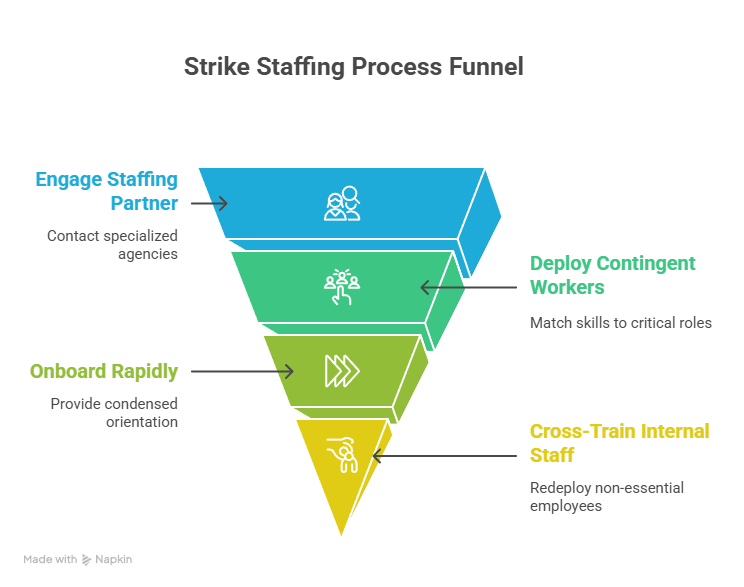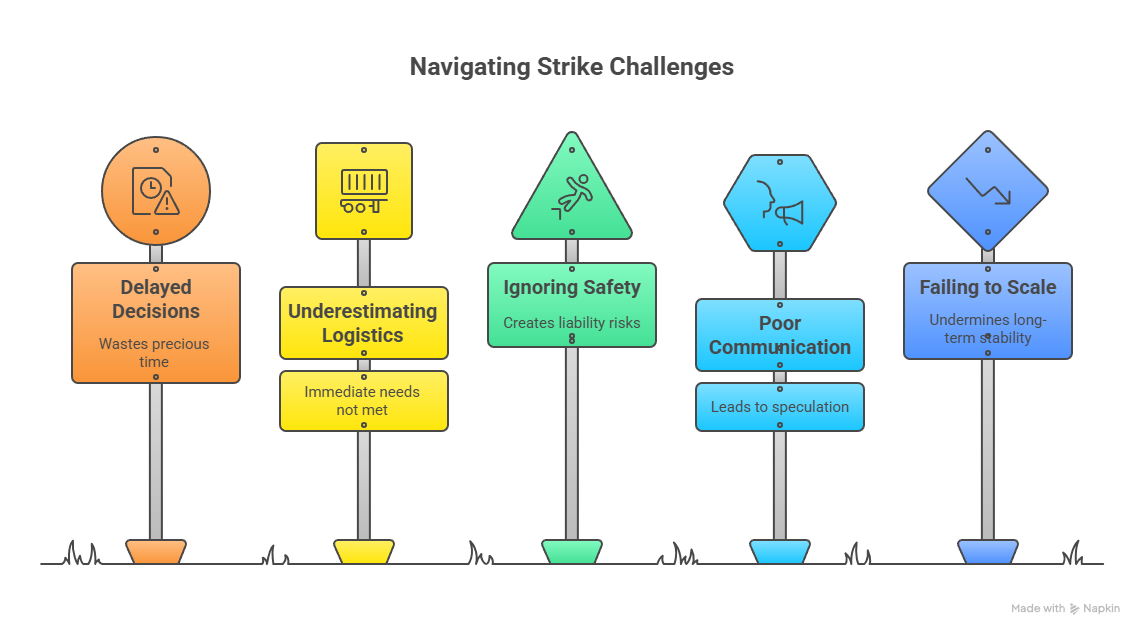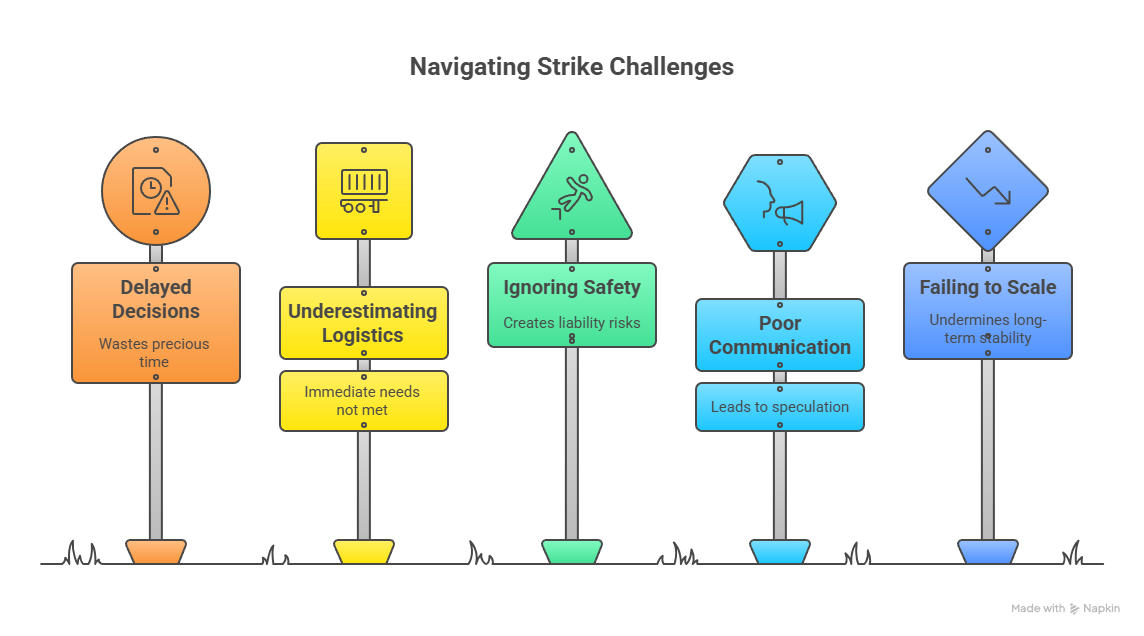
Discover the critical steps to maintain productivity in the first 48 hours of a labor strike
When a labor strike hits, the first 48 hours can determine whether operations stay on track or spiral into costly downtime. For organizations that rely on critical workforces — from hospitals and manufacturing plants to logistics hubs and warehouses — every hour of disruption carries significant financial and reputational consequences.
That’s why proactive strike staffing isn’t just a contingency plan; it’s a business survival strategy. A well-prepared response in the first 48 hours helps stabilize operations, reassure stakeholders, and maintain productivity while negotiations continue.
This playbook lays out a clear roadmap for what employers should prioritize during this critical window.
The High Stakes of Work Stoppages
Labor strikes are on the rise across the U.S., with industries facing higher union activity and tighter workforce dynamics. The costs are stark:
- Lost Revenue: Even a single day of halted production can cost millions in certain industries.
- Safety Risks: Understaffed operations create hazards for remaining employees and the public.
- Customer Disruption: Missed deadlines or canceled services erode trust quickly.
- Reputational Impact: Headlines about prolonged shutdowns can damage brand equity.
The organizations that weather strikes best are those that treat the first 48 hours as a stabilization mission — mobilizing resources quickly and sending a message of resilience.
Step One: Activate the Strike Response Team
The first move is organizational, not operational. Without clear leadership, even the best staffing plans collapse.
- Designate a Command Structure: Assign a strike response leader, supported by HR, legal, security, and operations leads.
- Define Roles Immediately: Each department needs clarity on decisions, reporting lines, and authority.
- Communicate Internally: Remaining employees should know where to report, who to contact, and what to expect.
This leadership framework ensures the company moves with speed and consistency rather than scrambling.
Step Two: Secure Workforce Continuity
The workforce is the backbone of strike response. Organizations must quickly stabilize labor capacity to maintain operations.
Key Actions in the First 48 Hours:
- Engage a Strike Staffing Partner: Pre-arranged staffing agencies with specialized labor pools can mobilize workers nationwide.
- Deploy Contingent Workers: Skilled temporary staff should be matched to the most critical roles first.
- Onboard Rapidly: Provide condensed orientation to align workers on safety protocols and job functions.
- Cross-Train Internal Staff: Where feasible, redeploy employees from non-essential functions.
The objective is not perfection — it’s continuity. Every role filled reduces downtime.

Step Three: Maintain Operational Safety
Strikes create operational instability. New workers, tense environments, and accelerated onboarding all increase risk.
- Prioritize Safety Training: Even brief sessions on equipment, PPE, and hazard awareness reduce incidents.
- Assign Safety Observers: Supervisors should monitor for risks in real time.
- Secure Facilities: Strikes can heighten tensions; security measures should protect staff, facilities, and replacement workers.
Maintaining safety in this window prevents setbacks that could compound disruptions.
Step Four: Communicate with Stakeholders
In the first 48 hours, silence breeds uncertainty.
Internal Communication
- Brief managers and supervisors with consistent talking points.
- Reassure remaining employees of stability and next steps.
External Communication
- Notify customers about potential impacts, but emphasize contingency plans.
- Update suppliers and partners to maintain confidence in delivery timelines.
The goal is to control the narrative — showing resilience and transparency rather than chaos.
Step Five: Monitor and Adjust Staffing Levels
Strike staffing is not static. Within the first 48 hours, leaders must assess whether the initial response is sufficient.
- Track Attendance and Productivity: Identify gaps where roles remain uncovered.
- Reallocate Resources: Shift replacement workers where they’re most needed.
- Stay Flexible: Be ready to scale staffing up or down depending on the strike’s trajectory.
This real-time adaptability prevents operations from drifting out of alignment.
The Role of Pre-Strike Planning
Organizations that execute smoothly in the first 48 hours almost always have one thing in common: advance preparation.
- Pre-Negotiated Staffing Agreements: Strike staffing partners ready to mobilize within 24 hours.
- Contingency Protocols: Playbooks detailing logistics, housing, and training of replacement staff.
- Scenario Testing: Tabletop exercises to simulate potential strike impacts.
Without preparation, the first 48 hours are spent playing catch-up. With it, the response is immediate and decisive.
Hour-by-Hour Playbook: First 48 Hours of a Strike
Hours 1–12: Stabilize and Assess
- Confirm Strike Status: Verify the official start time, scope, and expected duration.
- Activate Response Team: Leadership, HR, operations, and legal meet immediately to align priorities.
- Contact Staffing Partner: Notify strike staffing provider so replacement workers can mobilize.
- Secure Sites: Ensure entrances, exits, and sensitive areas are monitored for safety and security.
- Internal Announcement: Communicate calmly to non-striking staff, explaining continuity steps.
The first 12 hours set the tone. Uncertainty is inevitable, but fast communication and activation signal control.
Hours 12–24: Mobilize Resources
- Deploy Replacement Workforce: Workers begin arriving on-site or in staging areas.
- Provide Housing and Logistics: Many strike staffing firms coordinate lodging, meals, and transport for incoming workers.
- Onboard Replacement Staff: Accelerated orientation sessions cover safety, role-specific duties, and reporting procedures.
- Shift Scheduling: Establish initial schedules to ensure around-the-clock coverage.
- External Communication: Update customers, suppliers, and regulators with transparent but reassuring messaging.
This phase ensures the workforce gap is visibly closing, reducing operational shock.
Hours 24–48: Operate and Adapt
- Monitor Productivity: Supervisors assess performance of replacement workers and identify coverage gaps.
- Reallocate Staff: Move workers into critical bottlenecks (production lines, ER wards, or delivery routes).
- Extend Contingency Plans: Prepare to maintain staffing beyond 48 hours if negotiations stall.
- Engage in Negotiation Support: Ensure leadership continues labor talks while operations remain stable.
- Document Processes: Maintain records of actions taken for compliance and post-strike analysis.
By the end of 48 hours, the organization should feel stable and sustainable, ready for longer-term strike management if required.
Industry-Specific Strike Staffing Examples
Healthcare
Hospitals and clinics cannot afford lapses in patient care. Replacement nurses, technicians, and support staff must be credentialed and patient-ready within hours. Strike staffing ensures compliance with licensing standards while protecting patient safety.
Manufacturing
When production halts, supply chains ripple. Strike staffing fills critical roles in assembly lines, machine operation, and maintenance, helping manufacturers avoid missed quotas and costly downtime penalties.
Logistics and Warehousing
Freight bottlenecks and missed deliveries can cripple retail and e-commerce operations. Strike staffing ensures drivers, warehouse associates, and dispatchers remain on duty to keep goods moving.
Education
Teacher strikes leave students and parents scrambling. Strike staffing can provide substitute teachers, administrators, and support personnel to minimize disruption.
Energy and Utilities
For power plants, oil refineries, and water systems, strikes carry public safety implications. Replacement workers maintain essential operations while negotiations progress.
Cost Considerations in Strike Staffing
Employers weighing strike staffing often ask: What will it cost?
Key Expense Categories
- Wages: Replacement workers are often paid premium rates due to the urgency and conditions.
- Housing and Meals: Lodging near the site plus per diem stipends.
- Transportation: Flights, buses, and local transport for workers.
- Orientation Costs: Rapid training, PPE, and onboarding sessions.
- Security: On-site security teams to ensure worker and facility safety.
Why Costs Are Justified
While upfront expenses are significant, they often pale in comparison to:
- Daily revenue losses from halted operations.
- Penalties for missed contracts or deliveries.
- Reputational harm from service disruptions.
In short, strike staffing is an investment in business continuity.
Common Mistakes to Avoid in the First 48 Hours
- Delayed Decision-Making: Waiting too long to contact a staffing partner wastes precious time.
- Underestimating Logistics: Replacement workers need housing, food, and security in place immediately.
- Ignoring Safety: Rushing onboarding without safety emphasis creates liability risks.
- Poor Communication: Leaving customers, employees, or the media in the dark leads to speculation and mistrust.
- Failing to Scale: Not adjusting staffing levels as the strike evolves undermines long-term stability.
Avoiding these pitfalls helps ensure the response is efficient and credible.

Strike Staffing by State: First 48 Hours Based on Your Location
New York Strike Staffing
New York is one of the most strike-prone states due to its large unionized workforce and concentration of industries.
- Healthcare: Hospitals and nursing homes in New York City, Buffalo, and Albany frequently face labor actions that require rapid deployment of credentialed replacement nurses.
- Public Transit: MTA and regional transit strikes can shut down mobility for millions, making replacement staffing critical for operations continuity.
- Education: Teacher strikes have the potential to disrupt entire school districts.
First 48 Hours Priority: Mobilize licensed healthcare staff and ensure transit continuity under high public scrutiny.
California Strike Staffing
California leads the nation in labor strikes, with industries ranging from healthcare to logistics and education.
- Healthcare: Hospitals across Los Angeles, San Diego, and San Francisco regularly need replacement nurses and clinical staff.
- Ports and Logistics: Strikes at the Port of Los Angeles or Long Beach can ripple through global supply chains in hours.
- Education: Large-scale teacher strikes, particularly in LAUSD, require hundreds of substitute educators.
First 48 Hours Priority: Deploy credentialed healthcare staff while securing logistics and port operations to prevent national trade disruptions.
Texas Strike Staffing
Texas, with its energy, logistics, and healthcare industries, faces unique challenges.
- Energy Sector: Refineries and oil facilities in Houston, Beaumont, and Corpus Christi require OSHA-certified and skilled technical staff during strikes.
- Transportation: Dallas and Houston are major freight hubs; replacement drivers and warehouse staff are essential for continuity.
- Healthcare: Large hospital systems in Dallas, Houston, and Austin rely on strike staffing partners for licensed nurses and support staff.
First 48 Hours Priority: Balance immediate deployment in energy and healthcare while maintaining logistics flow statewide.
Illinois Strike Staffing
Illinois, particularly Chicago, is a national logistics and manufacturing hub.
- Warehousing and Freight: Chicago’s role in national rail and trucking networks means strikes can disrupt entire supply chains.
- Healthcare: Unionized nurses in Cook County hospitals require credentialed replacements when strikes occur.
- Education: Chicago Public Schools strikes have a history of demanding large-scale substitute staffing.
First 48 Hours Priority: Secure replacement workers for logistics and healthcare to prevent widespread regional disruption.
Florida Strike Staffing
Florida’s fast-growing workforce and mix of industries create varied strike risks.
- Healthcare: With large senior populations, hospitals and long-term care facilities require immediate coverage for patient safety.
- Hospitality and Tourism: Strikes in Orlando, Miami, or Tampa impact both domestic and international visitors.
- Education: Teacher actions can affect statewide school systems.
First 48 Hours Priority: Maintain healthcare staffing while ensuring continuity in service-heavy sectors like hospitality and tourism.
Pennsylvania Strike Staffing
Pennsylvania’s mix of healthcare, manufacturing, and education makes strike response complex.
- Healthcare: Philadelphia and Pittsburgh hospital systems often experience nursing strikes.
- Manufacturing: Steel and industrial facilities in western Pennsylvania rely on replacement skilled trades.
- Education: Large school districts and universities sometimes face prolonged strikes.
First 48 Hours Priority: Deploy replacement workers in healthcare and skilled trades to minimize disruption.
Ohio Strike Staffing
Ohio’s auto and industrial workforce makes it a focal point for labor actions.
- Automotive: Strikes in Toledo or Cleveland auto plants require skilled machinists and line workers.
- Healthcare: Statewide hospital systems depend on credentialed replacement nurses during walkouts.
- Logistics: With its central location, strikes in Columbus or Cincinnati warehouses can slow distribution.
First 48 Hours Priority: Stabilize automotive production lines and maintain healthcare operations.
Michigan Strike Staffing
Michigan’s identity as the automotive capital means strikes here carry global weight.
- Automotive Manufacturing: Union walkouts in Detroit-area plants can ripple through supply chains nationwide.
- Healthcare: Detroit and Grand Rapids healthcare systems often require rapid strike staffing.
- Education: Teacher actions have also shaped statewide responses.
First 48 Hours Priority: Prioritize auto industry staffing to keep production active while backfilling healthcare roles.
Massachusetts Strike Staffing
Massachusetts combines high healthcare density with education and biotech sectors.
- Healthcare: Boston hospitals rely on strike staffing to cover large numbers of unionized nurses.
- Education: Teacher and higher-education strikes disrupt academic calendars.
- Biotech and Research: Specialized staffing may be needed to maintain compliance in labs and R&D facilities.
First 48 Hours Priority: Rapid deployment of licensed healthcare and academic staffing.
Washington Strike Staffing
Washington state’s economy is tied to technology, logistics, and healthcare.
- Healthcare: Seattle-area hospitals often face labor actions requiring credentialed staff.
- Logistics: Strikes at the Port of Seattle or Tacoma can disrupt Pacific trade.
- Technology: While less frequent, tech support staff strikes can impact major employers.
First 48 Hours Priority: Protect port operations and ensure healthcare continuity.
FAQs: Strike Staffing Playbook
Can strike staffing be arranged before a strike occurs?
Yes. Many companies sign contingency agreements in advance, which allows staffing providers to mobilize workers within 24 hours.
Do replacement workers require specialized training?
It depends on the industry. In healthcare and energy, credentialing is mandatory. In manufacturing and logistics, condensed orientation ensures safe operations.
How do companies protect replacement workers during a strike?
Security protocols, safe housing, and coordinated transport minimize exposure to potential tensions.
What’s the typical duration of strike staffing coverage?
It ranges from a few days to several months, depending on the labor dispute. Most agencies scale staffing to match evolving needs.
Does using strike staffing impact negotiations?
It doesn’t replace bargaining. Instead, it gives employers leverage by ensuring operations remain stable while talks continue.









